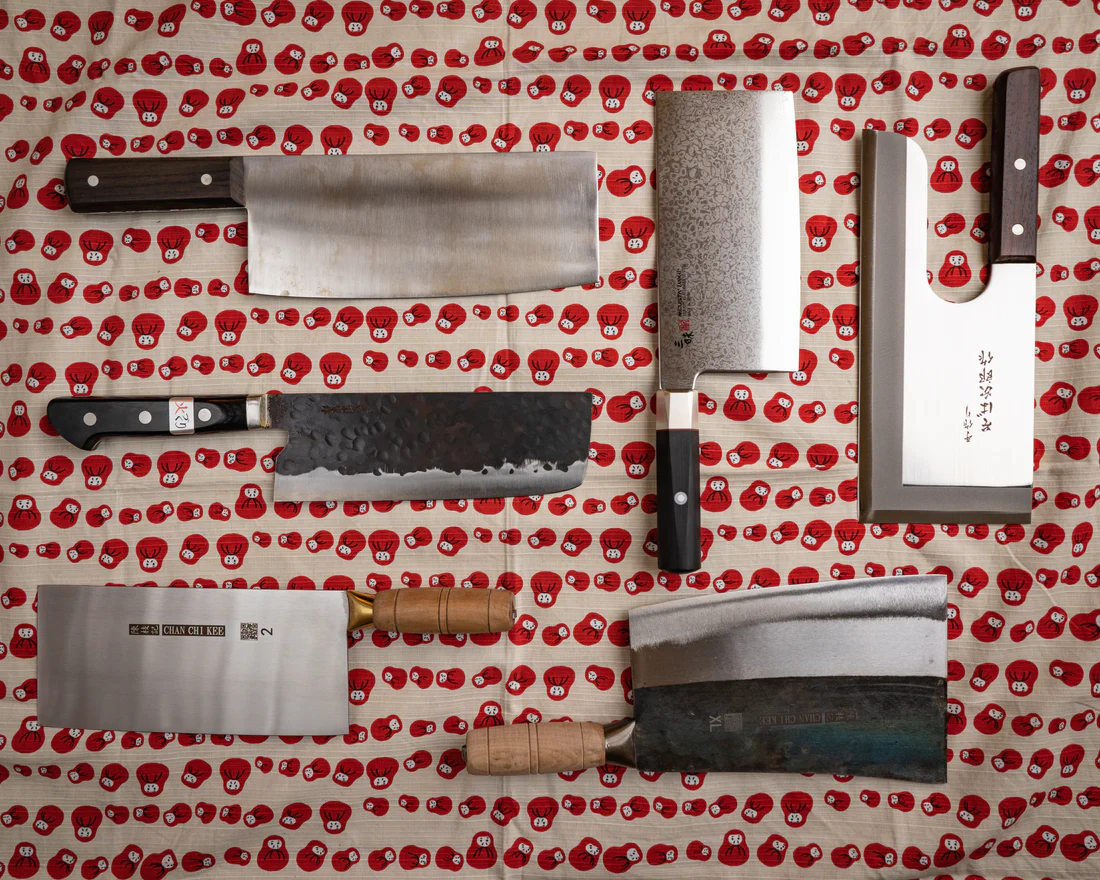
How to Use a Chinese Cleaver (Guide to the Illustrious Chuka Bocho)
I Like Big Knives, and I Cannot Lie: Tips and Tricks for Getting the Most Out of Japanese-made, Chinese-style Chef’s Knives
For the uninitiated a chuka bocho might seem intimidating, but with the following pro-tips you’ll be blasting through your food prep with a grin on your face in no time. All it takes is a bit of practice!
Don’t know what a chuka bocho is? You could check out my previous blog post, but here’s the Too Long, Didn’t Read (TLDR) version:
A chuka bocho is the Japanese version of the Chinese Cleaver. It’s a multipurpose knife that is great for slicing, dicing, mincing, and chopping all kinds of food. The Japanese steel means a chuka bocho will be sharper and stay sharp longer than its Chinese cousins. Chuka bocho may resemble meat cleavers, but they are generally not for cutting hard stuff like bones, lobster shells, frozen food, etc.

How to Hold a Chuka Bocho or Chinese Cleaver
The first thing you need to know is how to grip that big ol’ cleaver. A chuka bocho will have a balance point further out on the blade than other knives, so it’s important to choke up on it. The trick is to pinch the spine of the knife near the balance point with your index finger and thumb, which gives you more control and will be less tiring on your arm. Depending on the size of the cleaver relative to your hands, you might need to use a “peace sign” pinch with both index and middle fingers on the blade. Your non-knife hand should have the finger tips curled out of the way, and you make contact with the side of the blade using the second knuckle of your middle finger.

How to Cut with a Chuka Bocho or Chinese Cleaver
Next you’ll need to get the weight of the knife working for you—not against you. Sharp kitchen knives cut by sliding forward or backward along the edge, rather than just guillotining or chopping straight down by force. With a chuka bocho, you just push or pull the blade along the thing you want to cut while you stop supporting the weight. The feeling is like controlling your cleaver’s fall as it drops through the food and then picking it up again for the next cut. Once you get the hang of it, the rhythmic cycle of tension and release can become quite meditative. It’s also much less tiring than continuously supporting all that weight!
Although it might be tempting to try hacking and whacking with a chuka bocho, don’t do it! If you want a heavy knife for chopping bones and such, just get a meat cleaver.
Advantages of a Wide, Tall, Rectangular Kitchen Knife
Last, but not least, you’ll want to take advantage of the chuka bocho’s unique shape. The edge is curved like a smile (happiest knife in the world?), where the middle is flat-ish and then the profile lifts up towards the heel and tip. Some chuka bocho are curvier than others (the Moritaka’s edge is flatter than most), but the cutting technique remains fairly consistent. The idea is to ride the smiling curve with a slight rocking motion, which will be less pronounced while chopping and more exaggerated while slicing. Just pick up the cleaver, line it up on the food you want to cut, push or pull as you stop supporting the weight, and follow through as you make contact with the board again. Ride the smile!
The width of a chuka bocho also has some advantages over other knives. The tall, flat nose of the knife can be used to move food around on your cutting board. The broad side of the blade makes a perfect food scoop; I love the efficiency of finishing up some prep work only to move all the neatly cut pieces straight to the pot or pan in one smooth motion. The wide, flat side is also perfect for crushing garlic. The tall face of a chuka bocho makes it easy to control the pitch and tilt of the blade, so vertical, horizontal, and angled cuts are easier to keep consistent. While there is no pointy tip like a santoku or gyuto, the front point of a chuka bocho is surprisingly good for detailed work on products like mushrooms or shallots.
How to Clean a Chuka Bocho or Chinese Cleaver
Once you’re done cutting and scooping like a pro, you’ll need to clean the knife. If you wash your knife directly after using it, the clean up will be quick and easy!
The sheer size of a chuka bocho requires a slightly different technique than cleaning other kitchen knives. Rather than trying to wrap a dish cloth around the blade (you won’t be able to reach!), I just put a soapy cloth or sponge flat on the palm of my hand and wipe the blade. The safe direction to wipe is always away from the edge. Once the chuka bocho is clean, I rinse it with hot water and wipe it on a dry towel that is similarly laid flat on my palm.
Buying and Enjoying a Chuka Bocho
In case it isn’t obvious by now, I’m a big fan of Chinese cleavers. For people who weren’t raised with knives that shape (like me), there is a bit of a learning curve. My advice is to buy a chuka bocho, put your other chef’s knife/knives away for a bit, and use the cleaver for everything for a month. With some practice, you too will come to understand how truly fun and versatile a Chinese cleaver can be! I wouldn’t want to only use a chuka bocho for the rest of my life, but thirty days is enough to get comfortable with that shape.
Knifewear stocks a carefully curated selection of the finest chuka bocho imported directly from Japan. Check out the chuka bocho page on our website to get an idea of what we’ve got or come on down to one of our physical stores to get your hot little hands on one!
In my previous blog post, I provided short write-ups on a few chuka bocho that we try to stock regularly, that'll be a great place to start!





